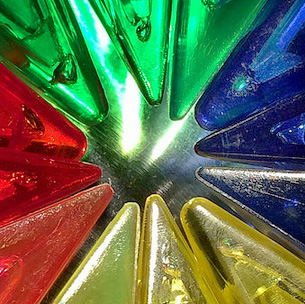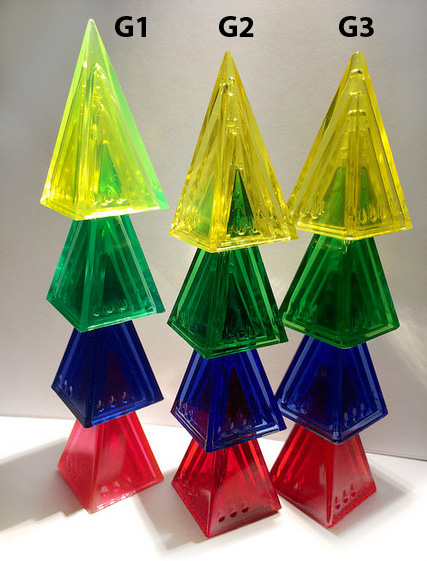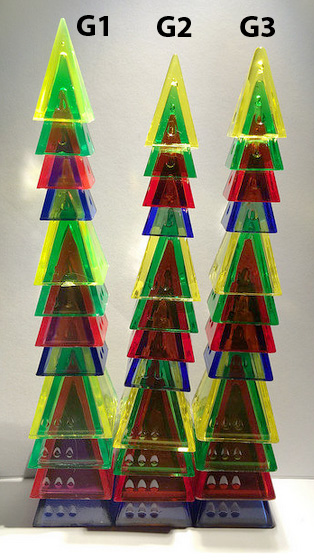A: Just before Pyramid Arcade came out Pyramid fans were curious about that newest generation of Looney Pyramids, which would have slightly rounder tips than the two previous manufacturing runs (which were themselves ever so slightly different from each other). Our goal, of course, is for all pyramids to be interchangeable and as otherwise identical to the other versions as possible, but concerns were expressed about stacking new ones onto old ones and having them look funny or something.
 So, Andy put together a test set consisting of four trios from each of the three production runs, with freshly opened pieces of each type, and he carried this set around in one of those awesome round tins he’s so fond of.
So, Andy put together a test set consisting of four trios from each of the three production runs, with freshly opened pieces of each type, and he carried this set around in one of those awesome round tins he’s so fond of.
These were his primary play-testing pyramids for a while, and he spent a lot of time stacking, nesting, and playing actual games using this set, to make sure the three types would all interact smoothly. He was happy to report that they’re great!
He also took a series of photos, which do reveal some slight differences:
For the purposes of this report:
G1 are the first type, made in the USA
G2 are the first set of Chinese-made pyramids, matching the first as closely as possible
G3 are from the newest Pyramid Arcade style, which are more rounded, to comply with EU safety regulations
(You may notice some odd colors in the photos: since he had some, he used G1 pieces with slightly non-standard colors (electric yellows and pinkish reds) to make them more easily distinguishable visually.)
These first three photos show that G1 pyramids do stack taller than the others, but he didn’t find that it mattered — or was even noticeable — in actual play.


|

|
The next four photos show the pyramids in mixed trios and stacks. Note that for the stacks of nests shown in the lower right photo, each nest has a mixture of all three generations of pyramids. Again, there are some very slight differences in how they stack, but it’s not something you’d notice, let alone feel is a problem, in actual use.



|

|
This last photo just shows G3 pyramids being stacked up in weird ways that, as you can see, are all still possible.

In closing Andy would like to say that, while he used to worry that rounder-tipped pyramids would feel inferior, once he actually had them in hand, he felt that, not only were they perfectly acceptable, he had to admit they were actually pretty nice. Maybe even better.